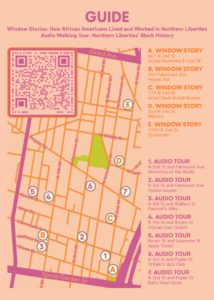Northern Liberties' Black History
Check out BHM events around the neighborhood
WINDOW STORIES
Visit five locations to learn more about people who lived and worked in Northern Liberties before the neighborhood was even a part of Philadelphia. This temporary installation of vinyl window decals was researched and written by Monna Morton, professor of advertising at University of the Arts. It is sponsored by the Northern Liberties BID and Color Reflections who printed and installed the decals.
You can use this map to help navigate both the audio walking tour and the Window Stories installation
WALKING AUDIO TOUR (CLICK TO PLAY)
(full text below)
Thank you for taking this tour of Northern Liberties, which has a focus on Black history. Though it is well known that this neighborhood was a crucial part of the Underground Railroad, this walking tour will help shed light on the real people who lived and worked here in the years prior to the Civil War.
To orient yourself during this tour, the numbered streets run north-south and increase in number headed west. Named streets such as Fairmount, Brown, and Poplar run east-west. This tour begins at the corner of 2nd and Fairmount and is a little less than a mile long. It can be completed in about half an hour.
Stop 1. Corner of Fairmount and 2nd
Through the 1800’s, 2nd Street was a bustling place with a market shed running down the middle of the street from Poplar to Fairmount and shops running the length on either side. Here, vegetable peddlers, fish mongers, and craftspersons of all kinds would sell their goods, and the very diverse residents of Northern Liberties – new European immigrants, free African Americans, and the working class – would gather to shop.
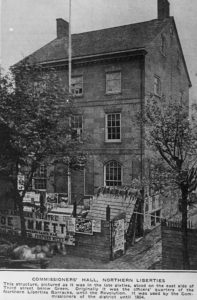
Before 1854 – the year Philadelphia ate up adjacent towns in a big consolidation – Northern Liberties was its own district with its own town hall. It was, for a time, considered the workshop of the world, having a density of manufacturing unparalleled in young America. The abundance of low-skill jobs and boarding houses attracted people looking to build a future for themselves, such as those escaping slavery in the South.
Turn to face the southwest corner, where the Chase ATM lobby is.
In the mid-1800’s, this corner looked very different. Instead of the brick buildings you see now, a row of inexpensive two- or three-story houses, most likely wooden, lined Fairmount Street. This corner was the home of Clarissa Cline who made her living washing and sewing, Richard Thomas, a brickmaker, and Peter Tunnell, a leather tanner whose family operated a carpet shaking business out of 717 N 4th. They were just a few of the thousands of free Black residents in Southeast Pennsylvania at a time when most of America’s Black population still lived under the yoke of slavery. Here in Pennsylvania, a free state, they would have been an integral part of the economy of the township of Northern Liberties. They would have worked in its tanneries, its sawmills, its brick furnaces, hat millineries, and corner pubs. They would have had their own businesses making everything from clothes to cabinets. They were, in effect, what helped make the neighborhood an industrial powerhouse.
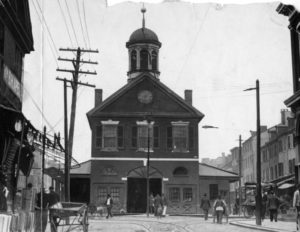
BLACK-OWNED BUSINESSES TO VISIT: 700 CLUB at 700 N 2nd, a locals bar where are all welcome. ReLoad Bags at 608 N 2nd produces hand-made messenger bags.
Head west on Fairmount.
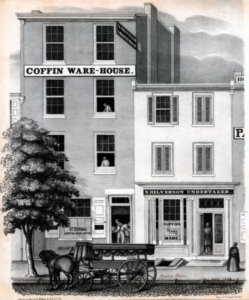
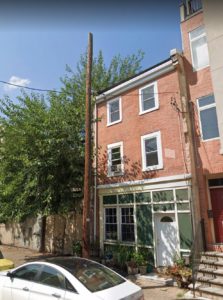
As you walk, you’ll begin to take in the eclectic character of Northern Liberties. Though there is a lot of new construction where wooden trinities once stood, many brick houses built in the early 1800’s are still standing, such as the home and workshop of bootmaker Samuel Krentz at 241 Fairmount. Like many artisans of the day, Krentz would have worked out of his house, built in 1855 on what was then called Coates Street. He would have drawn from the local labor pool, perhaps employing William Jeffers, a Black bootmaker who lived on nearby Lawrence Street.
Pause this audio tour until you get to 3rd Street.
Stop 2. Third and Fairmount
The numbered street system dates to the earliest days of Philadelphia, which ended at Race Street until the 1854 consolidation. The Abbaye restaurant occupies an ornate Victorian building dating from the late 1800’s. But before it was built, here stood the Edward Shanklin Oyster house, most likely a motely wooden structure that stank of seafood and ale. Oyster and porter houses were once common in old Northern Liberties, and numerous Black residents worked in the oyster business. Continue west so we can meet some of the residents of Wallace Street who shucked, waited, and cooked in them.
On your way, stop at 306 Fairmount to take in the mural dedicated to Black change-makers. Imagine what this house was like back when it was a tavern run by C.W. Klein.
Pause this audio tour until you get to 4th Street.
Stop 3. Paschall’s Alley
From Fairmount, turn left onto 4th Street. Stop a half a block in at Wallace Street.
Look up “Underground Railroad in Philadelphia” and Paschall’s Alley will be at the top of the search results. Now called Wallace Street, Paschall’s Alley was as it is now: narrow and cramped. Through the Underground Railroad network, those born into slavery – like John Parker, a leather tanner, or Richard Young, a laborer – got their start as free people on Paschall’s Alley. Ferried to Philadelphia through harrowing journeys, their freedom was eventually secured with money from relatives or abolitionist societies. They took up residence in overcrowded tenements, such as the one where 414 Wallace now stands. In 1847, 83 people occupied just 13 rooms here.
Their difficult journeys brought them into a community willing to help them find work in Northern Liberties’ many factories, bakeries, restaurants, and shops. Reflecting back to Edward Shanklin’s Oyster house, we can imagine Paschall Alley residents John Lewton, a waiter, Robert Davis, an oysterman, or Maria Tunnell, a cook, serving steaming bowls of chowder or freshly shucked seafood to hungry factory workers there.
Not all Black residents of Wallace came through the Underground Railroad. New Jersey born Jacob Bryant and his wife Eliza, for instance, opened a candies and confections shop at house 418. The few old structures that remain on this cobblestone alley were factories, and standing in their midst, we can conjure visions of the bustling place this once was.
When you are done exploring Paschall’s Alley, aka Wallace Street, return to 4th Street and turn left.
BLACK-OWNED BUSINESS TO VISIT: SUYA SUYA at the corner of 4th and Fairmount features fast causal West African cuisine.
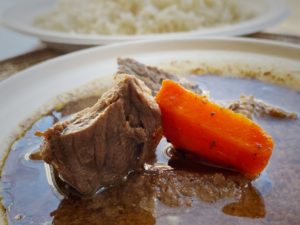
Continue north and pause this audio tour until you get to Brown Street.
Stop 4. 405 Brown Street
Turn left onto Brown Street, then stop at house 405.
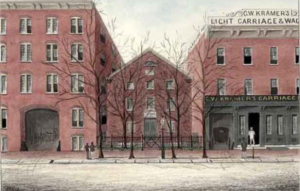
405 Brown Street is where the Zoar African Methodist Episcopal Church once stood. Undeniably, this modest brick church was central to Black life in Northern Liberties for almost a hundred years. In 1794 St. George’s Church in Old City tried to segregate its services, so a handful of its Black parishioners formed their own congregation in Northern Liberties, at first meeting in people’s homes before erecting a church building. Its congregation was active in the abolitionist movement and provided shelter and aid to fugitive slaves. They also ran a Sunday school to teach adults to read and acted as a foster home for children.
As the neighborhood rapidly expanded around it, Zoar found itself sandwiched between a Mason’s Hall and a bustling, loud carriage factory. The congregation moved to 12th and Melon Street in 1883, where it still operates today.
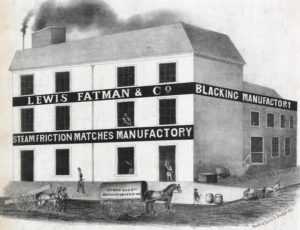
Head west on Brown and pause this audio tour unto you arrive at Lawrence Street.
Stop 5. Apple Street
Apple Street, as Lawrence was called before the consolidation, was another nexus of Black residents in Northern Liberties. There are several pre-civil war brick houses still standing today on the 900 and 1000 blocks of Lawrence that they once called home.
The corner of Apple and Brown was where street vendor Mary Thomas ran the Little Pepper Pot. Pepper pot was an inexpensive stew of Spanish and West African origin made with beef tripe and root vegetables. It was sold on the streets primarily by Black women, such as Mary. It would have also been a common menu item in Philadelphia taverns.
Across the street there is a row of homes built in the early 2000’s. But once, this was the location of Liberty Stove Works, an enormous campus of foundries which likely employed many laborers from Apple Street. It was eventually named after one of the stove work’s founders: Archilus Lawrence.
Turn right onto Lawrence and head north.
House # 808, formerly 4 Apple, housed the Johnson family and James Bird, Black residents who struggled to make ends meet in a labor market made competitive by the arrival en masse of Irish immigrants.
Continue north on Lawrence and pause this audio tour until you reach Poplar.
Turn right onto Poplar. Like many streets in Northern Liberties, Poplar now has a mix of old and new buildings. By the mid-1800’s, German immigrants – midwives, real estate agents, shoemakers, gardeners – began to coalesce on Poplar Street. House 417, one of the few older homes still standing, was the shop of watchmaker Frederick Audibert. The lovely, curved building at the corner of 4th and Poplar was a pawn shop.
Continue to 3rd Street and take a right. Pause this audio tour until you arrive at Ortlieb’s at 847 N 3rd Street.
Stop 6. Ortlieb’s
This bar takes its name from the famed brewery and bottling facility that took up much of the surrounding area through the 1990’s. Opening as a jazz club in 1987, Ortlieb’s grew to become one of Philadelphia’s most beloved places to play and enjoy music by attracting local and touring talent. Under new ownership, Ortlieb’s continues its tradition as an independent music venue.
Return to Poplar and take a right. Pause this audio tour until you get to 2nd Street.
Stop 7. Standard Tap
The famous Bull’s Head Hotel, built in the late 1700’s, was – and still is – a place to gather and raise a pint in Northern Liberties. Here in 1809 its then proprietor Thomas Leiper constructed a very early version of a railroad. The Standard Tap has a top-notch craft beer selection and a menu featuring interpretations of tavern classics like oysters and pepper pot.
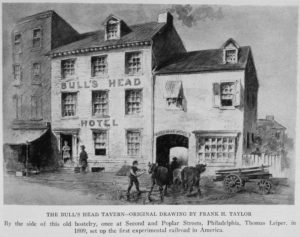
BLACK-OWNED BUSINESSES TO VISIT: Trunc, just north of here at 929 N 2nd showcases locally made goods. Maleek Jackson Fitness Boxing Gym which offers classes for children and adults.
Thank you for joining us for this audio tour, which is just a small slice of the rich history of Northern Liberties. For show notes, visit our website, explore northern liberties dot org, and sign up for our newsletter to stay up to date on all things Northern Liberties.
This tour was researched and written by Kristine Kennedy and ready by EJ …. Production by Mike Kennedy. Copywrite Northern Liberties Business Improvement District, 2022.
Additional Stops
North 3rd Restaurant
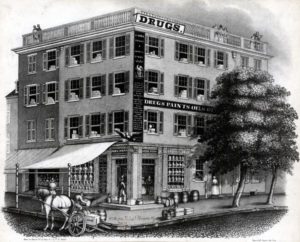
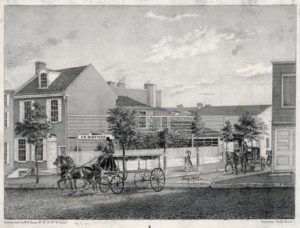
Resources and Show Notes
Workshop of the World Encyclopedia of Philadelphia details the many tanneries, breweries, and factories of Northern Liberties, some of which still stand.
Philadelphia historical maps: you can click on various maps and satellite images to see how the City has changed
PhilaPlace Timeline of Northern Liberties offers a concise, bulleted history going back to the Lenape and William Penn
NLNA audio history of Northern Liberties features first-person interviews with the urban pioneers who helped shape the neighborhood
Workshop of the World: Northern Liberties.focuses on the industrial past of the neighborhood
